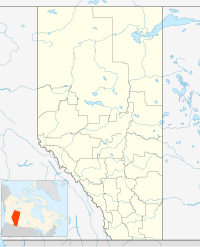Fort Dunvegan
| Dunvegan Provincial Park | |
|---|---|
|
Location of Dunvegan Provincial Park in Alberta
|
|
| Location | Fairview No. 136, Alberta, Canada |
| Nearest city | Fairview |
| Coordinates | 55°55′25″N 118°35′40″W / 55.92361°N 118.59444°WCoordinates: 55°55′25″N 118°35′40″W / 55.92361°N 118.59444°W |
| Governing body | Alberta Culture |
Dunvegan Provincial Park and Historic Dunvegan are a provincial park and a provincial historic site of Alberta located together on one site. They are located in Dunvegan, at the crossing of Peace River and Highway 2, between Rycroft and Fairview.
The site was the location of one of Alberta's earliest fur trade posts and missionary centres. The location of the original Fort Dunvegan is also a National Historic Site of Canada. It was built in 1805 by Archibald Norman McLeod and named for his family's ancestral home, Dunvegan Castle.
The historic site consists of a visitor centre and four historic buildings manned seasonally by historic interpreters. The campground consists of 67 sites with electrical hook ups, a day use area and playground. Dunvegan Provincial Park is jointly managed by the ministries of Alberta Tourism, Parks, and Recreation (the campground) and Alberta Culture (the historic site).
Dunvegan West Wildland Park is an extension of this provincial park.
Dunvegan is located on a flat of land on the north shore of the Peace River at a place where the river extends to its southernmost point in Alberta. The Peace is a relatively new river and indeed is still being formed as can be witnessed by the land slippages regularly occurring along its banks and the bars continually forming along its shores.
The river was created after glaciers from the last ice age began to melt some 15,000 years ago and a vast lake was created, covering virtually all of the Peace River Country. The lake was drained by the river which flows east then north as part of the Mackenzie Basin which empties into the Arctic Ocean.
As the glacial lake receded over the centuries, the river levels dropped. Traces of the shorelines can be detected on the edge of the broad promontory overlooking Dunvegan from the north. Eventually, a number of benches and flats appeared along the river, including the one which came to accommodate Dunvegan.
The flats were covered with huge deposits of alluvial soil which became lush with vegetation and teamed with wildlife. This was noted by Sir Alexander Mackenzie when he passed through on his famous journey to the Pacific Ocean in 1793. After passing near the eventual site of Dunvegan in May, he wrote:
...
Wikipedia

